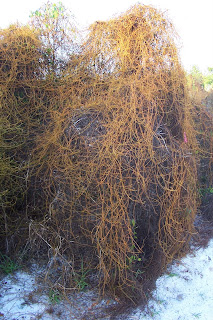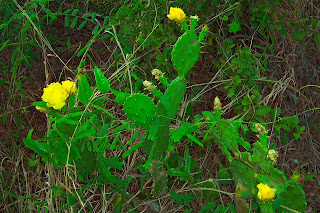
Most people think that the scrub is just a sea of browns and whites and drabness but if you look closely the scrub is actually full of color and beauty. Above is the fruiting American Beautyberry (Callicarpa americana) which is a shrub that can grow up to 6 feet tall. The bright purple fruit are very attractive to all sorts of wildlife.

The unique Love Vine (Cassytha filiformis) seen below is a parasitic plant that dominated most of the Seacrest Scrub I hiked through. It has a rich yellow glow to it and covers absolutely everything in its path but mostly shrubs. Cassytha is in the same family as avocado and cinnamon but it is the only parasite of the large Lauraceae family.
One of my favorite plants of South Florida is Wild Coffee (Psychotria nervosa). The leaves are so bright and shiny with highly textured veins. They have a bright red berry that many birds feed on but this coffee plant is not suggested for human consumption. Due to temperature requirements this plant is found mostly south from St. John's River in Florida.

Narrowleaf Silkgrass (Pityopsis graminifolia) is a new plant on my radar. It has beautiful yellow flowers and the overall silvery color of the leaf makes it easy to spot. This wildflower is a useful component for xeriscaping. It is grazed by livestock and wildlife, its rhizomatous growth habit is useful for controlling upland erosion. I've seen this plant many times in my life but I've never known its name until now. This is quite a charming little wildlflower.

The prize for the grandest of all flowers in the scrub belongs to the Prickly Pear Cactus (Opuntia humifusa). The giant yellow flower can be 3 to 4 inches across and if you look closely you may find one of the edible fruits attached. A few years back my friends and I harvested a bucket full of Prickly Pear fruit to make smoothies. After an hour of cutting all the spines off I called it successful but never to be attempted again. Those spines may not be large but they hurt like hell. The pads may also be cut up and used as a low-calorie addition to salads. Prickly Pear is a good source of potassium and fiber and also contains significant amounts of calcium and vitamin A. Like its western cousins, Prickly Pear retains moisture in its thick pads and is able to survive in very dry environments.
Spring time in the scrub not only offers cool hiking conditions but a nice sense of tranquility with the colorful plants. If you're in Florida, I definitely urge you to find some local sand ridges and talk a walk. You won't only find these beauties but you should also find Gopher Tortoises, Bobcats, and many species of lizard. If you're hiking in central Florida scrub you should also be on the look out for the Florida Scrub Jay, one of my favorite birds.




2 comments:
Lovely colours!!! Love the first pic!
Thanks! I'm a big fan of Beauty Berry.
Post a Comment